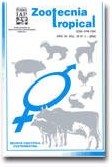
|
Zootecnia Tropical
Instituto Nacional de Investigaciones Agrícolas Venezuela
ISSN: 0798-7269
Vol. 21, No. 3, 2002, pp. 275-287
|
 Bioline Code: zt03018
Bioline Code: zt03018
Full paper language: Spanish
Document type: Research Article
Document available free of charge
|
|
|
Zootecnia Tropical, Vol. 21, No. 3, 2002, pp. 275-287
| en |
Different milling degree of ingredients in pellet diets for Nile tilapia ( Oreochromis niloticus  L.) during the growth phase. Performance and apparent digestibility L.) during the growth phase. Performance and apparent digestibility
Claudemir Martins Soares, Carmino Hayashi, Wilson Rogério Boscolo e Fábio Meurer
Abstract
To evaluate the effect of diets with different milling degree of ingredients (MDI) in pellet diets on performance and carcass characteristics of tilápia do Nile, 100 fingerlings were used with initial average weight of 11.92 ± 0.29 g, which were distributed in a randomized block design, with four treatments and five replications. The experimental diets had different MDI, as 0.50, 0.75, 1.00, and 1.50 mm mesh. It was observed a quadratic effect (P<0,05) on final mean weight, percent weight gain, total length, apparent feed conversion, and protein efficiency rate with the best values of 0.782, 0.789, 0.739, 0.656, and 0.734 mm. The body and fillet yields and visceral fat had the smaller values 0.969, 0.100, and 0.877 mm, respectively. The carcass yield showed a linear increase and the condition factor was not affected by the MDI. It was observed a quadratic effect (P<0,02) of the ingredients milling degree on dry matter, crude protein, and gross energy digestible apparent with maximum values of 0.691, 0.572, and 0.716 mm, respectively. It may be concluded that the milling degree of ingredients at 0.79 mm was the more adequate in pellet diets for Nile tilapia during the growth phase.
Keywords
Milling degree, Nile tilapia, Oreochromis niloticus, particle size, performance
|
| |
| es |
Diferentes graus de moagem dos ingredientes em dietas peletizadas para a tilápia do Nilo ( Oreochromis niloticus  L.) em fase de crescimento. Desempenho e digestibilidade aparente L.) em fase de crescimento. Desempenho e digestibilidade aparente
Claudemir Martins Soares, Carmino Hayashi, Wilson Rogério Boscolo e Fábio Meurer
Resumen
Objetivando avaliar os efeitos de diferentes graus de moagem dos ingredientes (GMI) em dietas peletizadas sobre o desempenho e características de carcaça da tilápia do Nilo, foram utilizados 100 alevinos com peso inicial médio de 11,92 ± 0,29g, em um delineamento em blocos casualizados com quatro tratamentos e cinco repetições. As dietas diferiram quanto ao GMI dos ingredientes em peneiras com 0,50; 0,75; 1,00 e 1,50 mm. Realizou-se um ensaio de digestibilidade com peixes com em media 47,81 ± 9,97 g e com as mesmas dietas. Observou-se efeito quadrático (P<0,05) sobre peso final médio, percentagem de ganho de peso, comprimento total final, conversão alimentar aparente e taxa de eficiência protéica com os maiores valores em 0,782; 0,789; 0,739; 0,656 e 0,734mm, respectivamente. Enquanto os rendimentos de corpo e de filé e a percentagem de gordura visceral apresentaram menores valores 0,969; 0,100; 0,877mm, respectivamente. O rendimento de carcaça apresentou aumento linear e o fator de condição não foi afetado pelos GMI utilizados. Os graus de moagem dos ingredientes proporcionaram efeito quadrático (P<0,02) nos CDA da matéria seca, PB, e energia bruta das dietas com valores máximos a 0,691; 0,572 e 0,716 mm, respectivamente. Conclui-se que a moagem dos ingredientes em peneira com abertura de 0,79 mm é a mais adequada para a confecção de dietas peletizadas para a tilápia do Nilo em fase de crescimento.
Palabras-clave
Desempenho, Granulometria, Oreochromis niloticus, moagem, processamento, tilápia do Nilo
|
| |
© Copyright 2003 - Zootecnia Tropical.
Alternative site location: http://www.sian.inia.gob.ve/repositorio/revistas_ci/ZootecniaTropical/ztindice.htm
|
|
